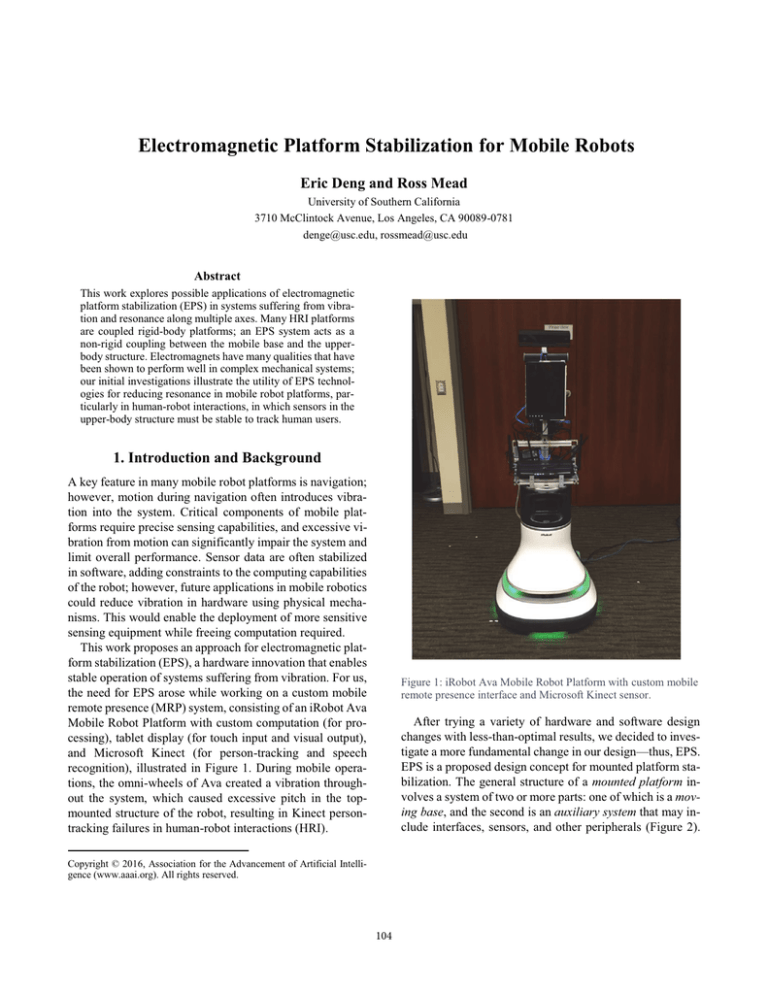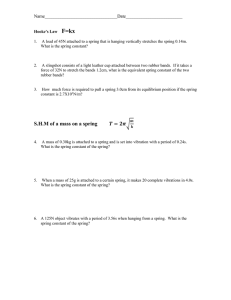
Electromagnetic Platform Stabilization for Mobile Robots
Eric Deng and Ross Mead
University of Southern California
3710 McClintock Avenue, Los Angeles, CA 90089-0781
denge@usc.edu, rossmead@usc.edu
Abstract
This work explores possible applications of electromagnetic
platform stabilization (EPS) in systems suffering from vibration and resonance along multiple axes. Many HRI platforms
are coupled rigid-body platforms; an EPS system acts as a
non-rigid coupling between the mobile base and the upperbody structure. Electromagnets have many qualities that have
been shown to perform well in complex mechanical systems;
our initial investigations illustrate the utility of EPS technologies for reducing resonance in mobile robot platforms, particularly in human-robot interactions, in which sensors in the
upper-body structure must be stable to track human users.
1. Introduction and Background
A key feature in many mobile robot platforms is navigation;
however, motion during navigation often introduces vibration into the system. Critical components of mobile platforms require precise sensing capabilities, and excessive vibration from motion can significantly impair the system and
limit overall performance. Sensor data are often stabilized
in software, adding constraints to the computing capabilities
of the robot; however, future applications in mobile robotics
could reduce vibration in hardware using physical mechanisms. This would enable the deployment of more sensitive
sensing equipment while freeing computation required.
This work proposes an approach for electromagnetic platform stabilization (EPS), a hardware innovation that enables
stable operation of systems suffering from vibration. For us,
the need for EPS arose while working on a custom mobile
remote presence (MRP) system, consisting of an iRobot Ava
Mobile Robot Platform with custom computation (for processing), tablet display (for touch input and visual output),
and Microsoft Kinect (for person-tracking and speech
recognition), illustrated in Figure 1. During mobile operations, the omni-wheels of Ava created a vibration throughout the system, which caused excessive pitch in the topmounted structure of the robot, resulting in Kinect persontracking failures in human-robot interactions (HRI).
Figure 1: iRobot Ava Mobile Robot Platform with custom mobile
remote presence interface and Microsoft Kinect sensor.
After trying a variety of hardware and software design
changes with less-than-optimal results, we decided to investigate a more fundamental change in our design—thus, EPS.
EPS is a proposed design concept for mounted platform stabilization. The general structure of a mounted platform involves a system of two or more parts: one of which is a moving base, and the second is an auxiliary system that may include interfaces, sensors, and other peripherals (Figure 2).
Copyright © 2016, Association for the Advancement of Artificial Intelligence (www.aaai.org). All rights reserved.
104
The EPS system acts as a physical bridge between the inherently unstable moving base and the auxiliary system, minimizing the amount of vibration transferred between them.
The basic physical structure of an EPS system consists of a
ball-and-cup connection with the ball joint being elevated in
the cup joint through a rigid, physical connection. This physical connection can be a hard solid-on-solid contact, a taut
cloth-like suspension connection, or even a strong magnetic
connection; the flexibility in this connection allows for interesting stabilization techniques, discussed below. Variable-strength electromagnets are embedded within the cup
joint, and can be controlled to mitigate the vibrations being
transferred between the moving base and auxiliary systems.
2.2. Suspended Ball-And-Cup Joint
With a suspended ball-and-cup joint (Figure 5), we can use
the tension of the suspension system to control the range of
vertical motion while also fine tuning the actual range of
roll, pitch, and yaw motion of the system as the vertical motion varies. The controls and physical hard-stops for the roll,
pitch, and yaw are controlled the same way, and the implementation of this suspended ball-and-cup joint further limits
the amount of vibrations being transferred through the joint.
Figure 3: A 3-dimensional model of the physical EPS structure.
Figure 2: Basic configuration of an EPS-enabled system.
Traditional solutions to this dynamics problems consider
using rubber-like materials to absorb vibrations, as well as
control systems for an inverted pendulum and multi-dimensional inverted pendula. While there have been attempts at
solving vibration transmission in dynamic conditions such
as our use case, the EPS solution combines controls of electromagnets and a physical joint with limited range of motion
to provide a simple and effective solution. The deployment
of EPS systems on mobile robot platforms provides a stable
platform upon which sensors and computation can be effective for real-time applications.
Figure 4: Classic ball-and-cup joint.
2. EPS Physical Structure
This section introduces the physical model and discusses the
benefits of the proposed EPS system.
2.1. Physical Ball-And-Cup Joint
The general design of the connection between the base and
auxiliary of the EPS system is a ball-and-cup joint (Figure
3). This design allows for coarse control of the range of motion by changing the ratio of the radii of the ball and cup;
however, as the design can be used in a variety of applications, some of which involve objects of larger mass, the connection can be constructed to include suspension systems.
Figure 5: Physical ball-and-cup joint (left) vs. suspended balland-cup (right)
105
2.3. Magnetic Stabilization
Now that the system is suspended and free to move around
in the ball-and-cup joint, we use n (where n > 1) electromagnetic pairs to control how the system is allowed to move
within the physically-defined bounds (Figure 6). This design
with n pairs allows for more freedom in application (Figure
7). When cost and packaging is a concern, such as in consumer products, fewer magnetic pairs may be used; however, for deployments in which accuracy is crucial, such as
in industrial settings that require fine adjustments and control, more sets may be used for precision.
We can even use variable-strength electromagnets to
form these electromagnetic pairs (Nagaya, 1995). By controlling the strength of each electromagnetic pair, we can
implement a system that varies the strength of the resistive
force in each axis of motion to minimize the transfer of vibrations from the base to the auxiliary system. The structure
the system could be implemented is described in Section 3.2.
3. Controls for Stabilization
Like previously mentioned, because the control of pitch,
yaw, and roll is controlled by the electromagnetic pairs and
these pairs can be made of variable-strength electromagnets,
we can build incredibly complex and specialized systems for
more specialized use cases. The control systems and implementation is described in the following sub-sections, as well
as the controls for the inverted pendulum problem.
3.1. The Classic Inverted Pendulum Problem
Stabilization of the Inverted Pendulum (Stimac, 1999) is a
problem that is often proposed in high-level dynamics as a
classic example of Lagrangian Dynamic Analysis (LDA)
because the inverted pendulum can be theoretically modeled
using LDA techniques.
After performing LDA on the desired model of an inverted pendulum system, one can build a model that uses the
encoded information on the drivetrain of the moving base to
tune the controls that describe the overall motion of the base
in each axis. A simple outline of the schematic of a proposed
pendulum-cart system (Stimac 1999) is illustrated in Figure
7. This model is a theorized 1-dimensional example for easier understanding but the same concept has been extrapolated and validated in much more complex systems—one of
which being the flying inverted pendulum (Hehn and D’Andrew 2011), an extension of the classical problem by balancing the inverted pendulum on top of a quadrotor aerial
vehicle. (Figure 8)
Figure 6: Electromagnetic pairs line the concentric walls of the
EPS system. A pair consists of one electromagnet on the outer wall,
and one ferromagnetic metal part on the inner wall.
Figure 7: Electromagnetic pairs numbering n located along the
sides of the EPS structure.
2.4. Control Range of Motion
If the desired limits in different axes are different, the balland-cup joint design is ideal. By simply changing the shape
of the opening in the cup joint, we can define the maximum
displacement of the ball joint for each 4 {0° ≤ 4 ≤ 360°}.
Figure 8: Schematic of classic inverted pendulum (Stimac 1999).
106
3.3. Resonance-Matching System
As the system uses electromagnets to mitigate vibrations
and as electromagnets can be built and controlled with extreme precision and speed, an effective feedback system can
be implemented that matches the vibrational frequencies of
the platform with the resonant frequency of the electromagnetic system. The proposed system is shown in Figure 10.
Figure 11: High-level system design.
The amount of control is flexible and the models being
implemented can be tuned to be within the desired tolerance
of the user. The range of control is determined by the accuracy of the model. The vibration of the platform along a particular axis is determined by the current motion (e.g., velocity, acceleration, jerk, etc.), the physical properties (e.g.,
mass, center of mass, etc.), the previous amount of vibration
along that axis, and the surface of motion. We are in the process of collecting data to build a model (g) to implement a
system that controls the force of the electromagnetic pairs
along each axis to minimize the vibrations along the axis (h).
Once a model of h is constructed, we will develop a general model for countering vibrations by changing the resonant frequency of the system, which is saved as future work.
Figure 9: Demonstration of a flying inverted pendulum.
Our first attempt at handling the vibrational noise that we
were seeing was actually a basic version of the inverted pendulum problem. There were certain speeds at which the
whole system would shake violently, so we added some
changes to the controller that minimizes the amount of time
that the robot spent at those velocities. Ultimately, our efforts led to a system that still underperformed; we are in the
process of improving the system in our ongoing work.
3.2. Variable-Strength Electromagnets
Using these electromagnets (Figure 10), we can design a
controller that changes the current through each electromagnet based on relevant factors such as velocity, masses of the
base and the auxiliary system, and models of floor materials.
Using this model of the strength of the magnetic force of
an electromagnet and generalized models of the relationship
between the motion of the system (including previous velocity and acceleration) and the floor surface and resonance,
we can implement a resonance matching control system,
similar to an inverted pendulum model (Figure 8).
4. Summary and Conclusions
We proposed the physical design of an EPS system and discussed the considerations for a ball-and-cup joint modified
for a variety of use cases. We then proposed the controls for
stabilization of the system, as well as a high-level design of
EPS based on related work with inverted pendula and the
general model of a variable-strength electromagnet.
Many mobile robots suffer from vibrations transferred
from the moving base to mounted sensor suites, which impacts the performance of the system. The proposed EPS system serves as an experimental option for generalized platform stabilization for mobile robots.
Acknowledgements
We thank Prof. Bingen Yang for his valuable insights on the
physical design and controls, and Caitlyn Clabaugh for her
assistance in visualizing the proposed system.
Figure 10: Generalized model of an electromagnet, like that proposed for EPS.
107
References
Hehn, M. and D'Andrea, R. 2011. A flying inverted pendulum. 2011 IEEE International Conference on Robotics and Automation (ICRA 2011), 763–770.
Nagaya, K. and Sugiura, M. 1995. A method for obtaining a linear spring for a permanent magnet levitation system using electromagnetic control. IEEE Transactions on Magnetics, 31(3):
2332–2338.
Stimac, A.K. 1999. Standup and Stabilization of the Inverted
Pendulum. Massachusetts Institute of Technology.
108



